Employee engagement model: Top 11 models, examples & best practices

In the midst of the 2020 global pandemic, many companies scrambled to adapt to remote work, but some thrived. Take Spotify, for example. As the world shut down, Spotify leaned heavily into flexibility, rolling out their "Work From Anywhere" policy.
Employees could choose where they worked—whether from home, a café, or even a different country. The result? Higher productivity, reduced burnout, and a surge in employee satisfaction.
This wasn’t a stroke of luck; it was a strategic move rooted in understanding what employees need to stay engaged and motivated. In a rapidly shifting world, businesses must rethink their approach to employee engagement.
So, how do you build an engagement model that resonates with your people? Let’s dive into what it takes to create meaningful connections and boost performance in today’s workplace.
Blog Highlights


Employee engagement model definition

Before we delve into the top models, let's make sure we're on the same page about what an employee engagement model is. At its core, an employee engagement model is a structured framework or approach that organizations use to understand, measure, and improve the level of engagement among their workforce.
Think of it as a roadmap that guides you through the twists and turns of keeping your employees motivated, committed, and happy. These models provide valuable insights and data-driven strategies to enhance the overall employee experience. By applying these frameworks, organizations can identify key engagement drivers, address potential issues, and create a culture of purpose, collaboration, and continuous growth.
Effective engagement models lead to higher retention rates, increased productivity, and a stronger connection between employees and organizational goals. Now that we have our bearings, let's explore the benefits of these models and learn from real-world examples how they can work wonders.



There is no quick fix or magic box for achieving employee engagement, it is a journey to connect your employees to your company. And. . . you can’t force your employees to join you on this journey!
HR consultant and Author
DebCo HR LTD
Why do we need employee engagement models?

Employee engagement models are essential for creating a workplace culture that fosters productivity, retention, well-being, innovation, customer satisfaction, goal alignment, and adaptability.
By investing in effective engagement strategies, organizations can cultivate a motivated and committed workforce, ultimately contributing to sustained success and growth.
- Productivity enhancement: Employee engagement models are imperative for boosting productivity within an organization. Engaged employees exhibit higher levels of focus, commitment, and enthusiasm, translating into increased efficiency and task accomplishment.
- Retention strategy: High turnover rates can be detrimental to a company's success, incurring significant costs in recruitment and training. Employee engagement models play a pivotal role in creating a workplace culture where employees feel valued, appreciated, and connected to the organization's mission.
- Well-being and job satisfaction: Employee engagement models often prioritize the overall well-being of employees. By focusing on aspects such as work-life balance, mental health support, and wellness programs, these models contribute to creating a healthier and happier workforce.
- Innovation and creativity: Engaged employees are more inclined to contribute innovative ideas and think creatively. Employee engagement models that encourage autonomy, provide platforms for idea-sharing, and allocate time for personal projects stimulate a culture of innovation.
- Customer satisfaction: Employee engagement framework directly influences customer satisfaction levels. Engaged and satisfied employees are more likely to provide excellent customer service, resulting in positive customer experiences.
- Alignment with organizational goals: Employee engagement models serve as a bridge between individual aspirations and organizational objectives. They provide a structured approach to aligning employees' efforts with the overarching goals of the company.
- Adaptability and resilience: In a rapidly changing business landscape, own employee engagement model contributes to building a workforce that is adaptable and resilient. Engaged employees are more likely to embrace change, navigate challenges, and contribute constructively during times of transformation.
Define team engagement
Team engagement refers to the collective commitment, enthusiasm, and involvement of team members toward achieving common goals and objectives. It encompasses the extent to which team members are emotionally invested in their work, collaborate effectively, and contribute towards the overall success of the team.
Team engagement goes beyond individual performance and focuses on the synergy and cohesion within the team.
A key aspect of team engagement is fostering open communication, trust, and mutual respect among team members. When team members feel valued and respected, they are more likely to actively participate in team activities, share ideas, and collaborate towards finding innovative solutions to challenges.
Moreover, team engagement involves providing opportunities for skill development, recognition, and feedback.
Empowering team members to take ownership of their work, providing constructive feedback, and acknowledging their contributions can further enhance team engagement and morale.



Employee engagement is the art and science of engaging people in authentic and recognized connections to strategy, roles, performance, organization, community, relationship, customers, development, energy, and happiness to leverage, sustain, and transform work into results.
Founder of Zinger Associates
Creator of The Zinger Model
Benefits of employee engagement models

Implementing employee engagement models in your organization offers a multitude of benefits, making them more than just theoretical concepts. Let's explore these advantages before we jump into real-world examples:
- Enhanced productivity: Engagement models can significantly boost productivity. Engaged employees tend to be more focused and committed, resulting in a 21% increase in profitability, according to a study by Gallup.
- Lower turnover: High turnover rates can be a costly problem for businesses. Engagement models can reduce turnover by creating a workplace where employees want to stay. For instance, Google is famous for its engagement strategies, which help them retain top talent.
- Improved employee wellbeing: Models often focus on the overall well-being of employees, leading to a healthier and happier workforce. Adobe, for example, provides its employees with a range of wellness programs, contributing to their overall engagement.
- Increased innovation: Engaged employees are more likely to come up with innovative ideas. An example here is 3M, which encourages its employees to spend 15% of their work hours on personal projects, fostering innovation and creativity.
- Customer satisfaction: Happy and engaged employees provide better customer service. Companies like Zappos prioritize employee engagement, resulting in exceptional customer satisfaction levels.
- Fostered team collaboration: Employee engagement models also play a crucial role in promoting team collaboration. When employees are engaged, they are more likely to work seamlessly with their colleagues, leading to improved collaboration and synergy within the organization.
- Skill development and continuous learning: Effective engagement models prioritize ongoing skill development and learning opportunities for employees. Companies that invest in training programs and skill-building initiatives, such as IBM's continuous learning platform, ensure that their workforce stays abreast of industry trends and advancements.
- Enhanced work-life balance: Employee engagement models often emphasize the importance of maintaining a healthy work-life balance. Organizations like Microsoft have introduced flexible work arrangements and remote work options to support their employees' well-being.
- Recognition and rewards programs: Acknowledging and rewarding employees for their contributions is a key element of engagement models. Companies like Salesforce have implemented robust recognition and rewards programs to motivate and appreciate their workforce.
- Improved employee retention: Engagement models contribute to higher employee retention rates by fostering a sense of loyalty and satisfaction among the workforce. Companies like Patagonia, prioritize employee well-being and career development, leading to long-term commitment and loyalty.
- Strengthened employer brand: Effective engagement models help build a positive employer brand, attracting top talent and enhancing the organization's reputation in the industry. LinkedIn, renowned for their employee-friendly policies and inclusive culture, enjoy a strong employer brand, making them an employer of choice for many professionals.
- Empowered leadership: Engagement models empower leaders to cultivate a supportive and inspiring work environment. Through effective communication and mentorship programs, leaders can nurture talent and drive motivation. Companies like Pixar Studios emphasize leadership development to create a culture of trust and empowerment.
- Promotion of diversity and inclusion: By fostering an environment where all employees feel valued and respected, organizations can harness the power of diverse perspectives and experiences to drive innovation and creativity. Companies like Airbnb implement inclusive policies and diversity training programs to create a more equitable and inclusive workplace culture.
Challenges in implementing an engagement model
Implementing an employee engagement model often comes with obstacles that require careful consideration and strategic solutions. Here are key challenges organizations commonly face:
- Cultural resistance to change: Introducing new engagement initiatives often disrupts established norms, leading to resistance. Employees and even leaders may hesitate to adopt new processes, especially if they feel disconnected from the rationale behind the change.
- Insufficient leadership buy-in: Without genuine support and commitment from leadership, engagement efforts can quickly falter. Leaders who fail to embody and champion engagement initiatives may inadvertently signal that these efforts are unimportant, hindering progress.
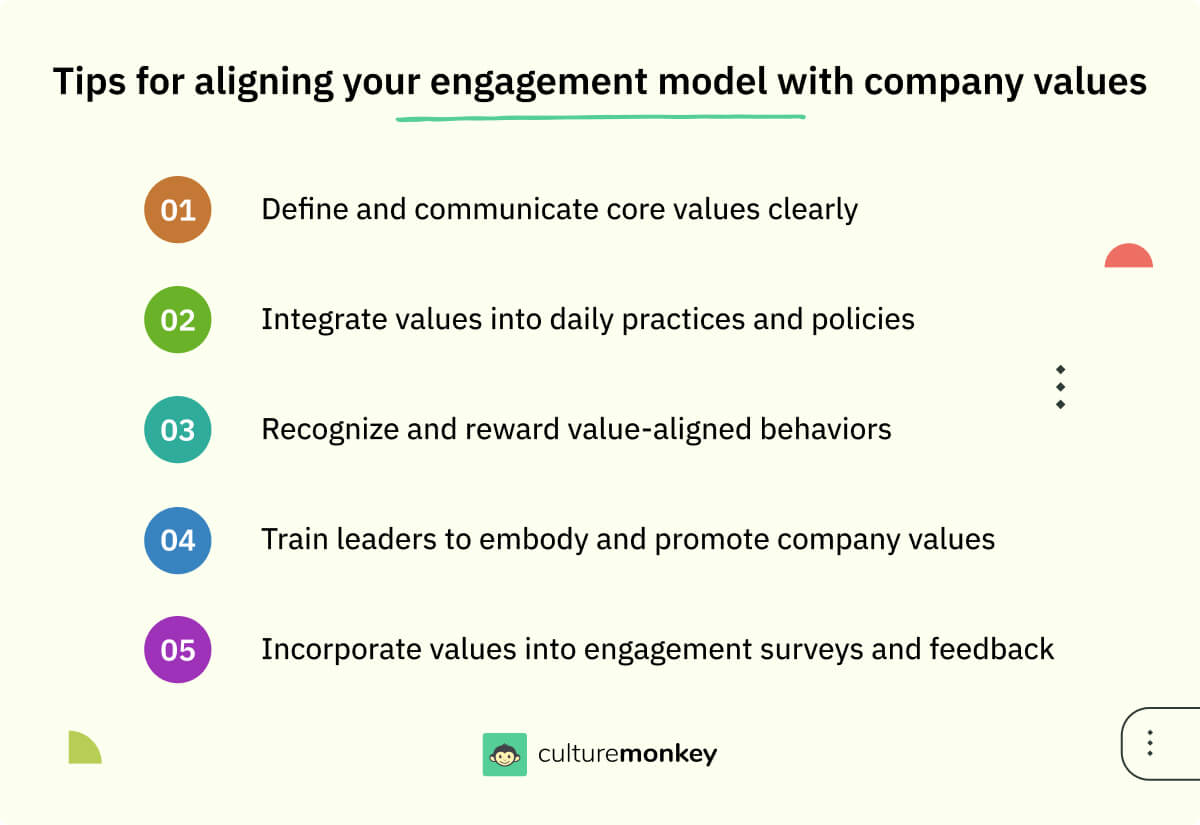
- Lack of consistency: Engagement efforts must be sustained to have lasting impact. Sporadic or inconsistent application of engagement strategies erodes trust and fails to deliver meaningful change, reducing employee enthusiasm over time.
- Inadequate resource allocation: Engagement initiatives often require dedicated time, budget, and human resources. Insufficient investment can lead to poorly executed programs that fail to address employee needs, resulting in frustration.
- Diversity and inclusion challenges: Designing engagement models that resonate with a diverse workforce is complex. Failure to account for different backgrounds, experiences, and needs can alienate employees, leading to disengagement.
- Lack of data-driven decision making: Many organizations fail to collect or utilize data effectively to measure engagement and guide improvements. Without actionable insights, engagement models may be ineffective, misaligned, or too broad to impact specific pain points.
- Poor communication of initiatives: Employees need to understand and believe in engagement efforts. Lack of clear communication and transparency around goals, expected outcomes, and progress undermines trust and engagement, limiting overall effectiveness.
Stages in an employee engagement model

An effective employee engagement model unfolds in distinct stages, each aimed at progressively fostering a more motivated, connected, and committed workforce. Here are the key stages that organizations must navigate:
- Awareness and education: The first stage involves building awareness of engagement principles among leaders and employees. By educating staff about the benefits and expectations of engagement initiatives, organizations lay the groundwork for alignment and buy-in.
- Baseline assessment: Conducting an initial engagement survey helps to establish a baseline understanding of current engagement levels. This data-driven approach identifies key areas of strength and areas that require focused improvement, guiding subsequent efforts.
- Strategic goal setting: Based on the initial assessment, organizations must set clear, actionable engagement goals. These goals should align with overall business objectives while addressing specific engagement gaps to ensure focus and relevance.
- Design and customization of initiatives: Engagement initiatives should be tailored to meet the unique needs of the workforce. Whether through flexible work arrangements, wellness programs, or career development, customized initiatives demonstrate commitment to employee well-being.
- Implementation and integration: Engagement efforts must be seamlessly integrated into daily operations. By embedding these initiatives within core business processes, organizations ensure consistent reinforcement and a greater likelihood of sustained engagement.
- Ongoing feedback and refinement: Continuous feedback loops ensure engagement strategies remain effective. Organizations must regularly collect input, measure impact, and refine initiatives to reflect evolving employee needs and expectations.
- Sustained recognition and reinforcement: Recognizing and celebrating successes reinforces positive behaviors. Acknowledging individual and team contributions sustains momentum and strengthens long-term commitment to engagement efforts.
What are the 7 components of employee engagement?
Employee engagement is a multifaceted concept that comprises several components. While the specific components may vary in different models and approaches, a commonly recognized framework includes the following seven components of an employee engagement strategy:
- Job satisfaction: Employee engagement often begins with job satisfaction. When employees are content with their roles, responsibilities, and the work environment, they are more likely to be engaged.
- Organizational commitment: Engaged employees are committed to the organization's mission, values, and goals. They feel a strong connection to the company's success.
- Well-being: Employee well-being is a critical component of engagement. It encompasses physical, mental, and emotional health. Organizations that support their employees' well-being tend to have more engaged and productive workforce.
- Personal growth and development: Engaged employees are continuously learning and growing in their roles. They seek opportunities for skill development, advancement, and personal growth.
- Work relationships: Positive relationships with colleagues and supervisors play a significant role in the engagement outcomes. Engaged employees feel connected to their coworkers and have supportive relationships with their managers.
- Recognition and rewards: Acknowledgment and rewards for a job well done are essential for engagement. Employees who receive recognition for their efforts tend to be more engaged and motivated.
- Work-life balance: A healthy work-life balance is crucial for engagement. Organizations that promote flexibility and support employees in maintaining a balance between their professional and personal lives often have more engaged employees.
What are the 3 P's of employee engagement?
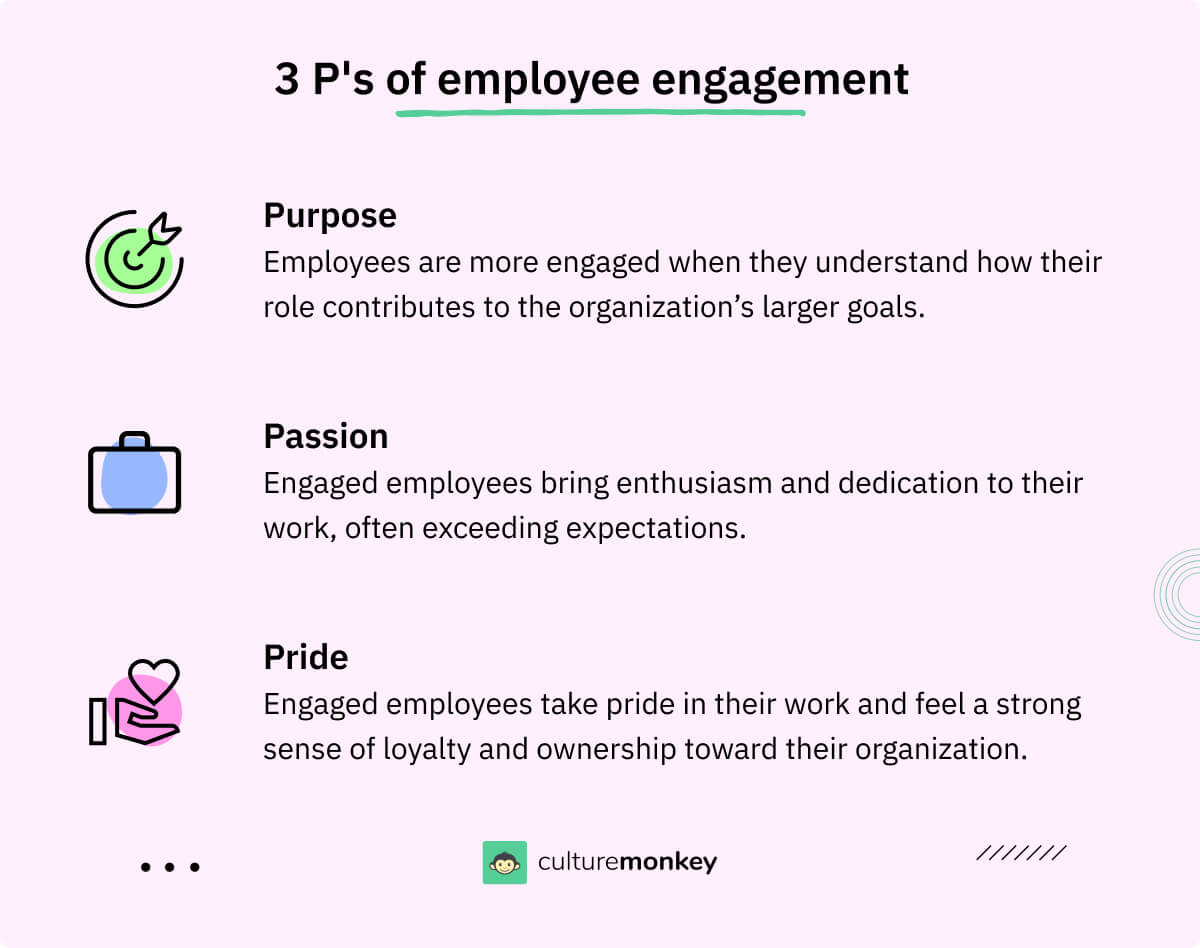
There are 3 P’s that are the driving forces behind a motivated and satisfied workforce. Let's delve into the heart of each P to understand their vital role
- Purpose: Employees are more engaged when they have a clear sense of purpose in their work. They need to understand how their role contributes to the larger goals of the organization. When employees see that their work has a meaningful impact, they are more likely to be engaged and motivated.
- Passion: Passion refers to the enthusiasm and dedication employees bring to their work. Engaged employees are passionate about what they do, and they often go above and beyond their job descriptions because they genuinely care about the work and the organization.
- Pride: Employees who are engaged take pride in their work and in being a part of their organization. They feel a sense of ownership and loyalty, and they are proud to be associated with the company. This pride leads to higher levels of commitment and satisfaction.
What are the 5 E's of engaged employees?
There are 5 E's of employee engagement that provide a holistic framework for nurturing a motivated and productive workforce. Let's dive into each of these E's:
- Empowerment: Empowered employees have the authority and autonomy to make decisions and take ownership of their work. They feel that their contributions matter and have a say in how tasks are accomplished, which increases their engagement.
- Enrichment: Enrichment refers to providing opportunities for skill development, learning, and personal growth. Employees who feel that they are continuously developing and expanding their abilities tend to be more engaged.
- Environment: A positive work environment is crucial for engagement. This includes physical aspects like a comfortable workspace and also the organizational culture, which should be supportive, inclusive, and respectful.
- Equality: Equality in the workplace ensures that all employees are treated fairly and have access to the same opportunities and resources. When employees perceive fairness and equal treatment, their engagement levels tend to be higher.
- Entertainment: While work is serious, adding an element of fun or enjoyment to the workplace can enhance engagement. This could include team-building activities, social events, or simply finding ways to make work more enjoyable.
What are the 11 models of employee engagement?

Employee engagement is the heartbeat of a thriving workplace. To nurture this vital aspect, organizations employ various models.
Let's dive into these models and see how they can transform your workplace into a hub of enthusiasm and productivity.
1. William Kahn's Model of Employee Engagement
Developed by William A. Kahn, this model focuses on the concept of "personal engagement." It highlights how employees invest their complete selves into their work, emotionally, cognitively, and physically.
Kahn's model encourages organizations to create a meaningful work- environment where employees feel a sense of belonging and find meaning in their roles, leading to higher levels of engagement.
For instance, tech giant Apple is known for emphasizing employees connecting deeply with the company's mission, enhancing personal engagement.
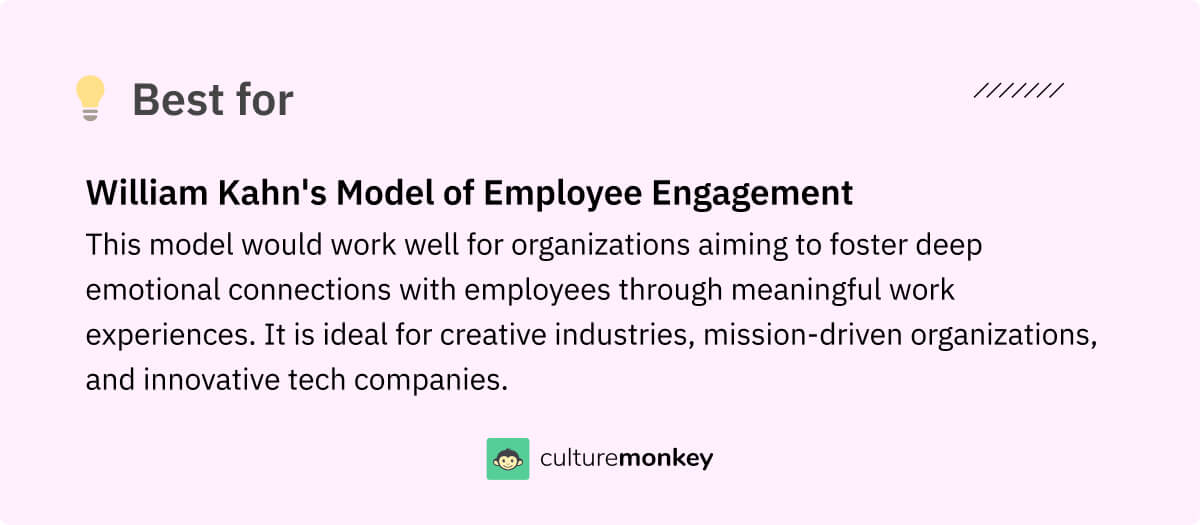
2. Gallup's Q12 Model
The Gallup Organization has been a pioneer in the field of employee engagement. The Gallup employee engagement model consists of 12 key questions that help measure and improve employee engagement efforts.
These questions focus on aspects like clarity of expectations, personal growth opportunities, and the relationship with supervisors.
Well-known global companies like Microsoft have effectively used the Gallup Q12 model to understand and enhance employee engagement levels, resulting in improved workplace morale and productivity.
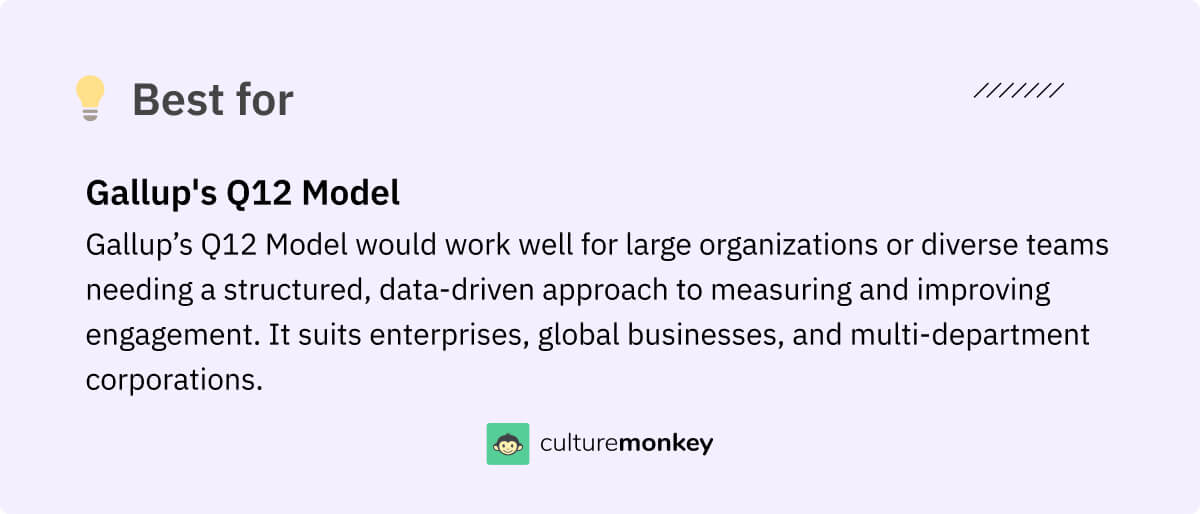
3. Maslach and Leiter's Six Areas of Work-life Model
Christina Maslach and Michael Leiter's model focuses on six key areas that impact employee engagement: workload, control, reward, community, fairness, and values.
It addresses the importance of creating a balanced work environment where employees have a sense of control, are fairly rewarded, and feel connected to their colleagues and the organization's values.
The healthcare institution, Cleveland Clinic, is a prime example of an organization implementing this model effectively. They emphasize employee workload management, foster a strong sense of community, and align their values with their employees' experiences.
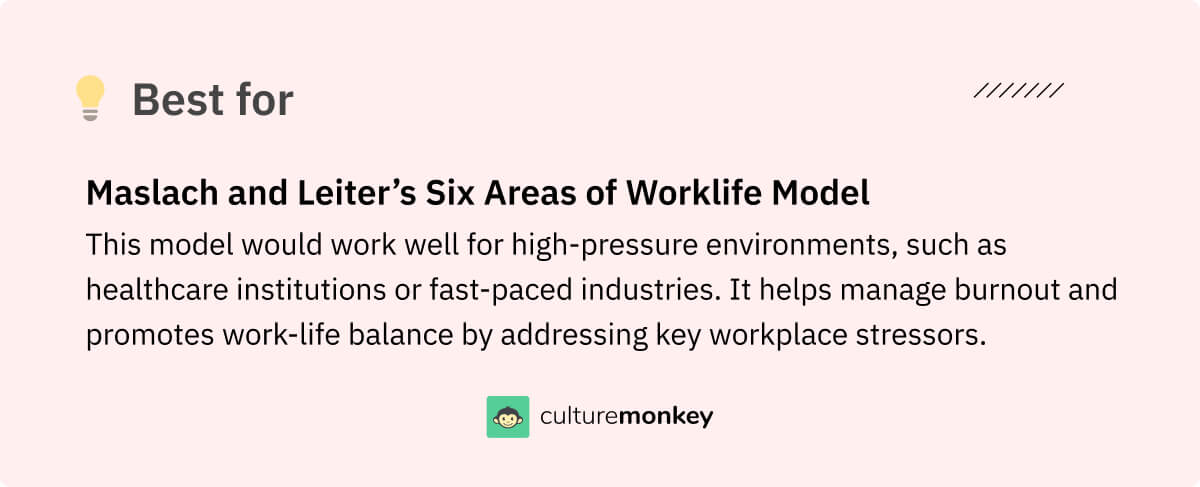
4. Aon Hewitt's Engagement Model
Aon Hewitt's model takes a comprehensive approach to employee engagement by assessing engagement at three levels: engagement with the work, engagement with the team, and engagement with the organization.
This model recognizes that engagement is a multi-dimensional concept and should be addressed holistically.
Corporations like Hilton Worldwide have implemented this model, focusing on all three engagement levels, resulting in high levels of employee engagement drivers, satisfaction and customer loyalty.
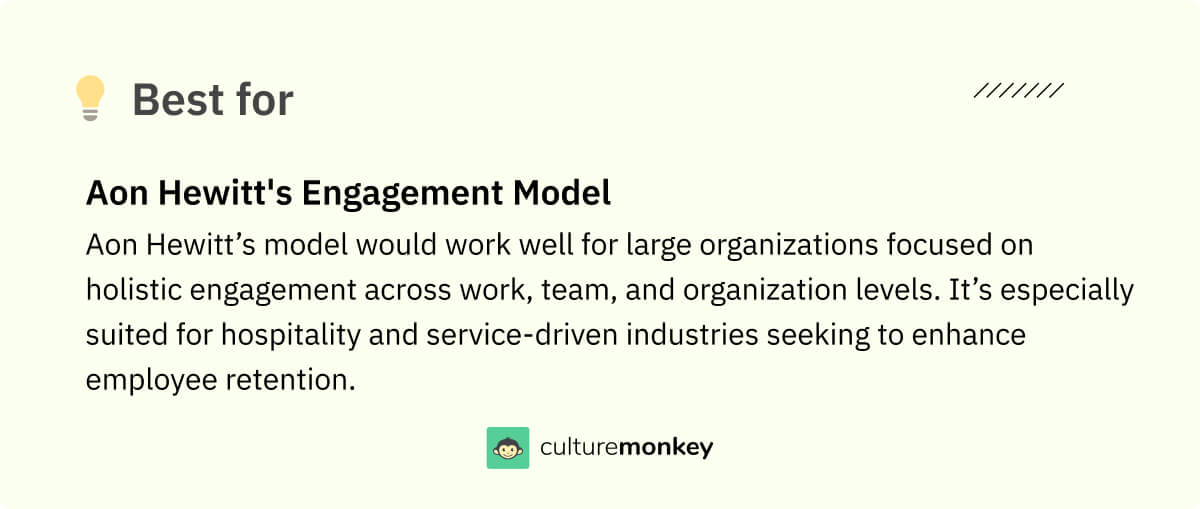
5. Hackman and Oldham's Job Characteristics Model
Developed by J. Richard Hackman and Greg Oldham, this model emphasizes the design of the job itself as a crucial factor in employee engagement.
The Job Characteristics Model identifies five core job dimensions - skill variety, task identity, task significance, autonomy, and feedback - that contribute to an employee's overall job satisfaction and engagement.
Companies like Procter & Gamble have successfully applied this model by designing jobs that offer a variety of tasks, a clear sense of purpose, autonomy, and regular feedback, resulting in higher levels of employee engagement and job performance.
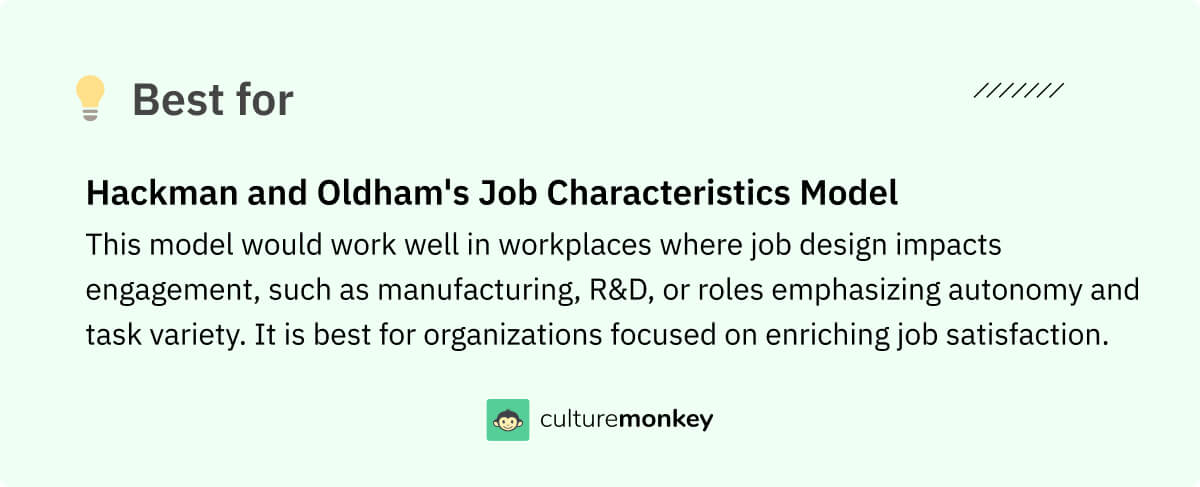
6. Tower Watson's Total Rewards Model
Tower Watson's model expands the scope of employee engagement by incorporating the concept of total rewards. It recognizes that engagement goes beyond traditional compensation and benefits, encompassing aspects like career development opportunities, work-life balance, and recognition.
Organizations like IBM leverage the Total Rewards Model to create a comprehensive approach to employee engagement. By offering a holistic set of rewards and recognizing various facets of employees' contributions, they foster a more engaged and motivated workforce.
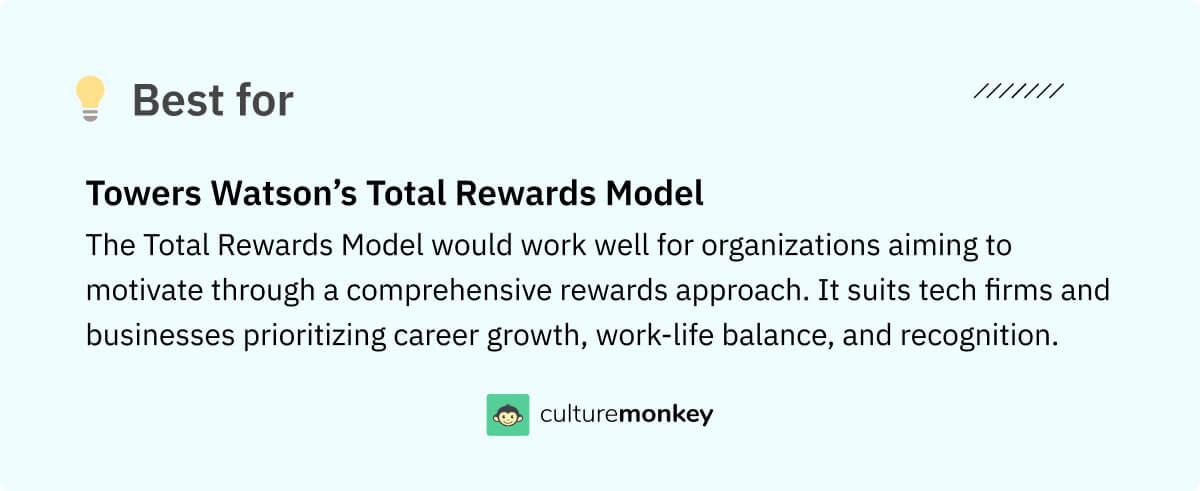
7. Schneider's ASA Model
The Attraction-Selection-Attrition (ASA) Model, developed by Benjamin Schneider, highlights the role of organizational culture in employee engagement.
According to this model, individuals are attracted to organizations with cultures that align with their values. The organization, in turn, selects and retains employees who fit its culture.
Companies like Southwest Airlines have embraced the ASA Model to create a unique organizational culture that attracts individuals who resonate with their values. This cultural alignment contributes to higher levels of employee engagement and satisfaction.
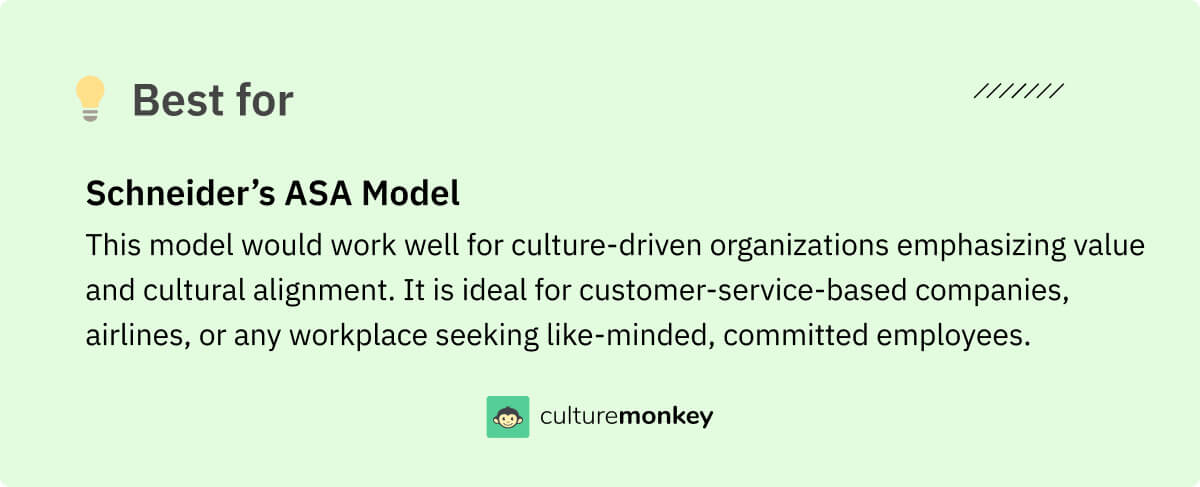
8. The JD-R Model (Job Demands-Resources Model)
The JD-R model, developed by Arnold Bakker and Evangelia Demerouti, emphasizes balancing job demands and available resources to enhance employee engagement. According to the model, high job demands (e.g., tight deadlines, workload) can lead to burnout unless adequately supported by job resources (e.g., support from colleagues, autonomy, career opportunities).
By managing these factors, organizations can maximize engagement and productivity.
Leading companies like Google leverage this model by ensuring employees have ample resources to meet challenging tasks, such as access to cutting-edge tools, career development programs, and flexible work arrangements.
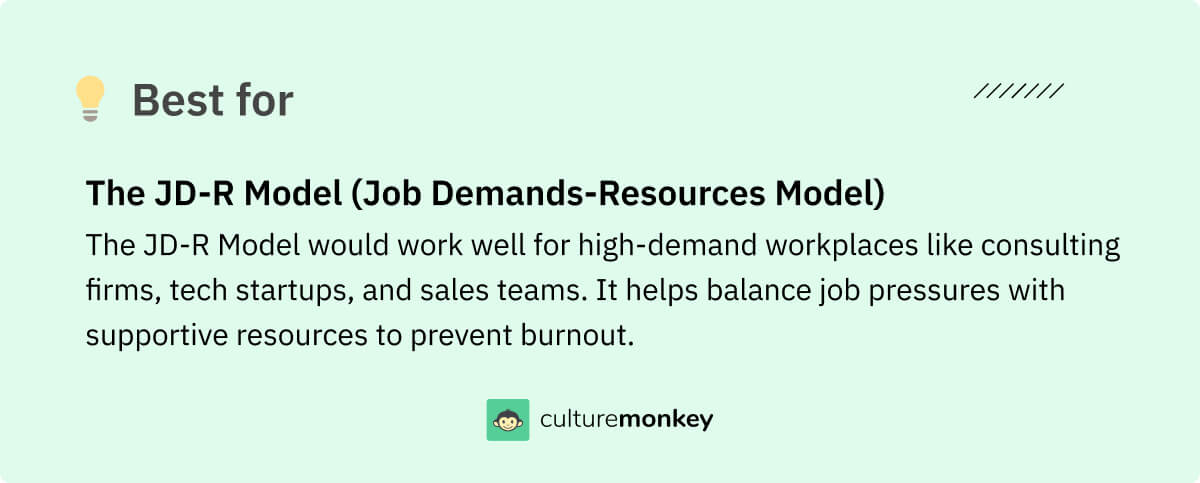
9. The Maslow Model (Hierarchy of Needs)
Maslow's Hierarchy of Needs, adapted for employee engagement, suggests that organizations must meet employees' fundamental needs before expecting full engagement. It starts with basic needs (job security, compensation), followed by social needs (collaboration, camaraderie), and culminates in self-actualization (opportunities for growth and meaningful work).
Organizations such as Zappos have successfully applied this approach, offering competitive salaries, strong social cultures, and ample room for employees to innovate, leading to deeply engaged and motivated employees.
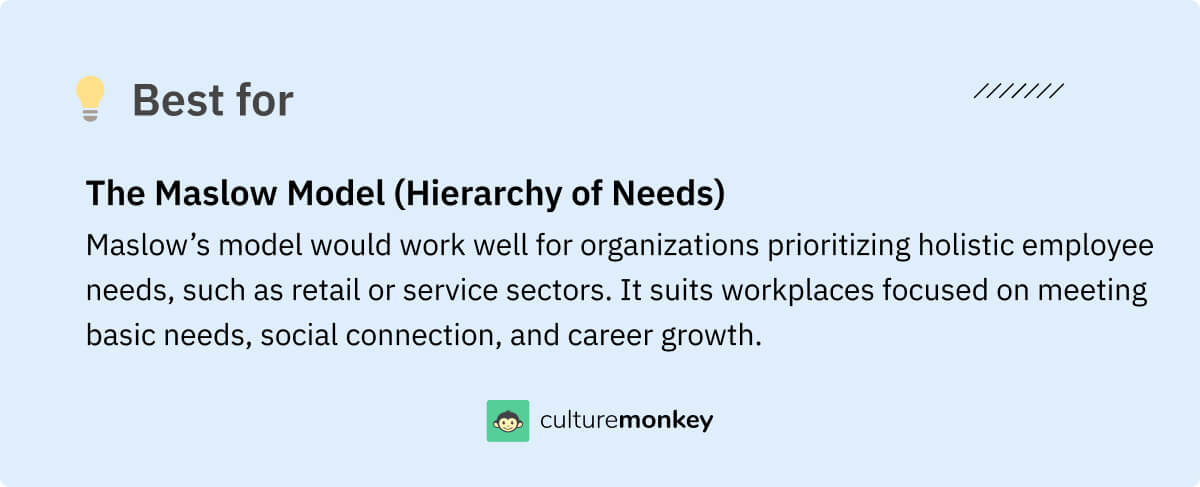
10. The Zinger Model of Employee Engagement
Developed by David Zinger, this model focuses on a holistic approach to employee engagement, emphasizing ten building blocks results, recognition, relationships, and meaning.
Many small and mid-sized enterprises have benefited from adopting Zinger’s model, fostering strong connections between employees and the organization's mission, resulting in higher morale and productivity.
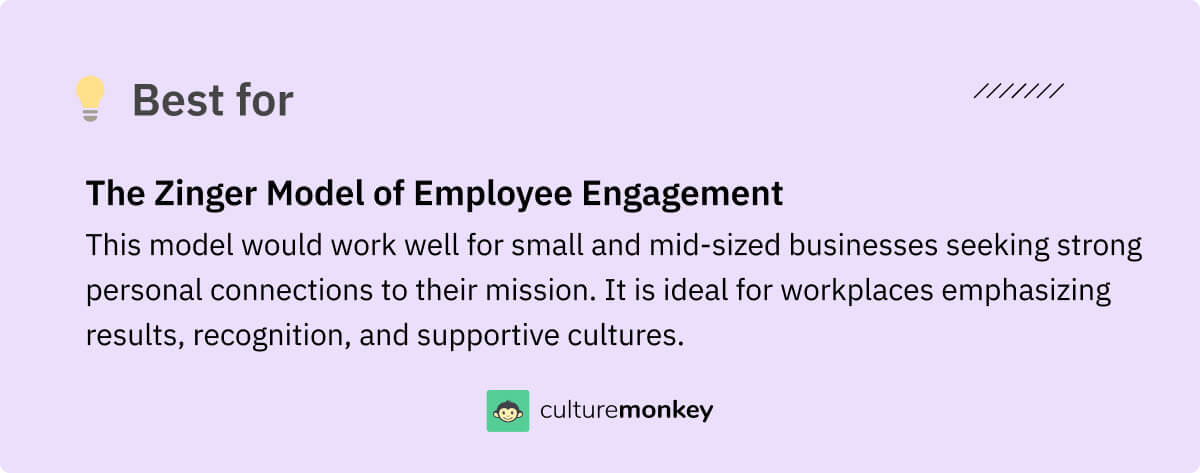
11. The Deloitte Model
The Deloitte Model emphasizes the importance of leadership, culture, and continuous improvement in employee engagement. It advocates for a culture where leaders inspire, communicate transparently, and build trust. This model integrates frequent performance check-ins and fosters an inclusive environment that encourages personal and professional growth.
Deloitte itself is a prime example of the model's success, using it to create a culture of continuous engagement, flexibility, and development opportunities for its global workforce, driving loyalty and high engagement levels.
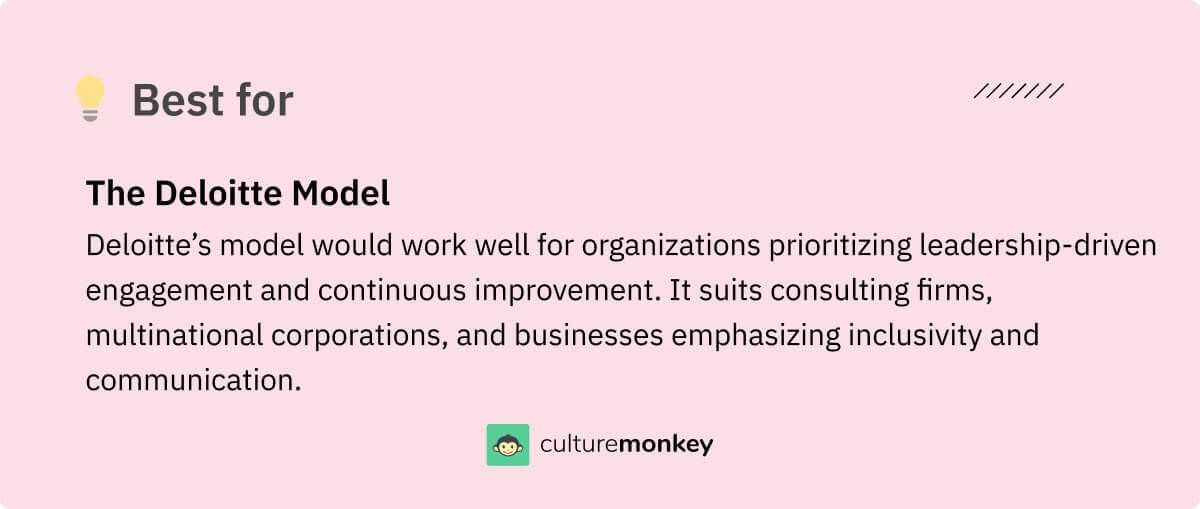
Employee engagement model best practices
Now that we've explored employee engagement models and their various facets, let's dive into some best practices for implementing these models effectively. These practices can help organizations maximize the benefits and business outcomes of their chosen employee engagement model:
- Leadership support: Employee engagement starts at the top. Leaders must champion the cause and demonstrate their commitment to the model. Their actions and behaviors set the tone for the entire organization.
- Clear communication: Transparent communication is essential. Employees need to understand the purpose of the model, how it benefits them, and how it aligns with the organization's goals.
- Customization: Tailor the model to your organization's unique needs. What works for one company may not work for another. Consider your industry, culture, and employee demographics when implementing the model.
- Continuous feedback: Regularly collect feedback from employees to gauge the effectiveness of the model. Use surveys, focus groups, and one-on-one discussions to understand what's working and where improvements are needed.
- Training and development: Invest in employee training and development programs. This not only enhances their skills but also shows that the organization is committed to their growth.
- Measurement and metrics: Use data to track the impact of the model. Key performance indicators (KPIs) can help you assess the model's effectiveness and make data-driven improvements.
- Leadership development: Develop the leadership skills of managers and supervisors. They play a vital role in implementing the model at the team level.
- Consistency: Maintain a consistent approach to engagement. Consistency builds trust, and employees need to see that the organization is committed for the long haul.

Employee engagement that delivers.
Discover the key questions that will transform your workplace into a hub of motivation, connection, and productivity.
What is employee engagement theory?

Employee engagement theory focuses on creating a mutually beneficial relationship between employees and their organization, fostering motivation, satisfaction, and commitment. It emphasizes that engaged employees are emotionally invested in their work and are more productive and loyal.
By understanding key engagement theories, organizations can better meet employee needs, boost morale, and drive success. Here are some prominent theories in employee engagement:
- Job Demands-Resources (JD-R) Model: Engagement is influenced by job demands (e.g., workload, time pressure) and job resources (e.g., social support, autonomy). Properly balancing these factors can reduce stress and boost fulfillment.
- Social Exchange Theory: This theory highlights reciprocity, stating that employees are more engaged when they perceive the organization invests in their well-being, support, and recognition, leading to loyalty and higher performance.
- Two-Factor Theory (Herzberg): Differentiates between hygiene factors (salary, job security) and motivators (recognition, personal growth), noting that true engagement arises from addressing both sets of needs.
- Self-Determination Theory (SDT): Focuses on fulfilling employees' psychological needs for autonomy, competence, and relatedness, leading to intrinsic motivation and stronger engagement.
- Cultural Engagement Theory: Emphasizes aligning organizational culture and values with employee beliefs to create a sense of belonging and deeper connection.
6 Employee engagement model examples to get inspiration from
Employee engagement isn't a one-size-fits-all concept. To spark creativity and motivation in your workplace, it's valuable to draw inspiration from successful models. Here are five outstanding examples to ignite your own employee engagement theories and initiatives
1. Google's "Project Oxygen"
Google's Project Oxygen is a well-known example of an effective engagement model. They analyzed data from employee surveys and performance evaluations to identify the key behaviors of their best managers.
This model emphasizes qualities such as being a good coach, empowering employees, showing concern for their success and well-being, and fostering innovation. By implementing these behaviors in their management approach, Google significantly improved engagement and productivity.
2. Microsoft's "Gallup Q12 Model"
Microsoft is a prime example of an organization that has successfully implemented Gallup's Q12 model. This model focuses on 12 key questions that measure engagement.
Microsoft uses these questions to continuously assess and improve engagement and engagement levels, ensuring employees are aligned with the company's goals and mission.
3. Zappos' "Culture of Wow"
Zappos, an online shoe and clothing retailer, has a unique approach to engagement with their "Culture of Wow." They emphasize a strong company culture that values both employees and customers.
Zappos offers training, team-building activities, and encourages employees to express their creativity. This commitment to culture has led to high employee engagement and exceptional customer service.
4. Salesforce's "Ohana Culture"
Salesforce, a leading CRM company, is known for its "Ohana Culture," inspired by the Hawaiian concept of family and community. They prioritize employee well-being, inclusivity, and giving back to the community.
Salesforce's commitment to these principles has fostered a culture of trust and engagement, resulting in high employee satisfaction and strong customer relationships.
5. Southwest Airlines' "LUV" Culture
Southwest Airlines is renowned for its unique engagement model centered around its "LUV" culture, which stands for Love, Understanding, and Valor. This model prioritizes creating a supportive and inclusive work environment where employees feel valued and empowered.
Southwest encourages open communication, employee recognition, and opportunities for personal and professional growth. This focus on employee well-being and development has contributed to the airline's success and high levels of employee engagement.
6. Airbnb's "Belong Anywhere" Philosophy
Airbnb's engagement model revolves around its "Belong Anywhere" philosophy, reflecting the company's commitment to diversity, inclusion, and belonging. They strive to create an inclusive workplace culture where employees from diverse backgrounds feel welcome and valued.
Airbnb offers various programs and initiatives to support employee well-being, such as flexible work arrangements, diversity training, employee resource groups, and guidance on maximizing benefits like Airbnb tax deductions. This emphasis on inclusivity fosters a sense of belonging among employees, driving higher levels of engagement and collaboration.
Choosing the right employee engagement model for your company

Selecting the right employee engagement model framework for your company is a crucial decision that can impact productivity, retention, and overall employee satisfaction. Here's a step-by-step guide to help you make an informed choice:
- Understand your company's needs: Begin by identifying your organization's specific needs and objectives. Are you aiming to reduce turnover, increase productivity, foster innovation, or improve overall job security and satisfaction? Understanding your goals will guide your choice of an appropriate model.
- Assess your company culture: Take a close look at your company culture and values. Your chosen engagement model should align with your organization's mission, vision, and core beliefs. This ensures a seamless integration of the model into your existing culture.
- Analyze your workforce: Consider the demographics and needs of your employees. Different generations and roles within your organization may require unique approaches to engagement. Tailor your model to address the specific needs of your workforce.
- Research available models: Explore various employee engagement models and frameworks. The examples provided earlier can serve as a starting point. Evaluate their components, principles, and success stories to see which one resonates most with your organization.
- Customization: Remember that you can customize and combine elements from different models to create a unique framework that suits your organization. Consider creating a hybrid model that takes the best aspects of various approaches.
- Employee involvement: Involve your employees in the decision-making process. Conduct surveys, focus groups, or one-on-one interviews to gather their insights and preferences. Their input can provide valuable guidance in selecting the most appropriate model.
- Leadership buy-in: Ensure that your leadership team is committed to implementing and championing the chosen model. Their support is critical for its success.
- Pilot programs: Before fully implementing the model, consider running pilot programs in specific departments or teams. This allows you to test its effectiveness, gather feedback, and make adjustments as needed.
- Measurement and evaluation: Establish key performance indicators (KPIs) and measurement tools to assess the impact of the model. Regularly review the data and make improvements based on the results.
- Continuous improvement: Recognize that engagement is an ongoing process. Be prepared to adjust and refine your model as your company evolves and as new best practices emerge.
- Incorporate diversity and inclusion: Consider diversity and inclusion as integral factors in your engagement model selection. Ensure that the chosen framework promotes a diverse and inclusive workplace culture, addressing the unique needs and perspectives of all employees.
- Alignment with remote work: In today's dynamic work environment, assess the compatibility of the engagement model with remote work scenarios. Choose a model that accommodates flexible work arrangements and provides strategies for engaging remote teams.
- Sustainability focus: Incorporating sustainability initiatives in your model not only enhances employee engagement but also aligns with broader societal values.
- Peer benchmarking: Benchmarking against peer organizations can offer valuable insights, allowing you to learn from their experiences and tailor your approach to fit your company's unique requirements.
- Consider technological integration: Evaluate how technology can support your chosen engagement model. From communication tools to performance management software, incorporating technology can streamline processes and enhance employee experience in today's digital workplace.
- Promote work-life integration: Acknowledge the importance of work-life integration alongside work-life balance. Encouraging employees to integrate personal interests and responsibilities into their workday can contribute to overall well-being and satisfaction.
- Emphasize transparency and communication: Prioritize transparency and open communication channels within your engagement model. Keeping employees informed about company goals, decisions, and changes fosters trust and alignment with organizational objectives.
Measuring the effectiveness of your employee engagement model
Assessing the effectiveness of an employee engagement model is critical to ensure it delivers the intended impact on organizational culture, productivity, and employee satisfaction. Here are key ways to measure its success:
- Employee retention rates: High employee turnover may indicate disengagement, while low turnover suggests that engagement initiatives are positively influencing workplace loyalty. Tracking retention rates over time helps gauge the effectiveness of your model in creating a committed workforce.
- Pulse surveys: Unlike traditional annual surveys, pulse surveys offer frequent, real-time feedback from employees. These short, targeted surveys provide a more dynamic understanding of engagement levels and highlight emerging issues quickly.
- Productivity metrics: Measuring changes in productivity and performance metrics helps connect engagement initiatives with business outcomes. Increased output, higher-quality work, and improved customer satisfaction can be indicators of a more engaged workforce.
- Quality of internal collaboration: Assessing the level and quality of cross-team collaboration can reflect employee engagement. High engagement often correlates with greater teamwork, cooperation, and innovative problem-solving across departments.
- Managerial feedback and observations: Managers interact with employees daily and can offer valuable qualitative insights into engagement levels. Collecting structured feedback from managers provides context and helps refine engagement efforts.
- Absenteeism rates: Low absenteeism rates can signal increased motivation and job satisfaction. Monitoring changes in sick leave or unplanned absences provides clues to engagement progress.
- Benchmarking against industry standards: Comparing engagement metrics with industry benchmarks helps contextualize results. This allows organizations to identify areas of strength and opportunities for improvement relative to competitors.
Role of an employee engagement platform in implementing your model

Implementing an engagement model is a pivotal step in enhancing your organization's performance and employee satisfaction. However, to effectively bring this model to life, an employee engagement platform plays a crucial role. Here's how it contributes to the process:
- Data collection and analysis: Engagement platforms help collect and analyze employee feedback and data, providing insights into the effectiveness of your engagement model. This data-driven approach allows you to make informed decisions and tailor your model for better results.
- Communication and feedback: These platforms facilitate seamless inernal communication and feedback channels. Employees can express their thoughts, concerns, and suggestions, fostering a culture of openness and collaboration, which is often a key component of successful engagement models.
- Recognition and rewards: Many engagement platforms offer tools for recognizing and rewarding employees for their efforts. These features align with models that emphasize appreciation and reinforcement as part of their strategy.
- Goal tracking and performance metrics: Engagement platforms enable the tracking of key performance metrics to achieve your employee engagement goals, which is crucial for measuring the impact of your model. You can monitor changes in employee satisfaction, productivity, and other relevant KPIs.
- Employee development: Some platforms offer resources for employee development and training, which align with models focusing on personal growth and development as a core component of engagement.
- Customized surveys and assessments: Employee engagement platforms allow for the creation of customized surveys and assessments tailored to specific aspects of your engagement model. This flexibility enables organizations to gather targeted feedback on various initiatives, ensuring a more nuanced understanding of employee sentiments.
- Gamification features: Integrating gamification elements within engagement platforms can enhance participation and enthusiasm. By incorporating game-like elements, such as challenges, leaderboards, and rewards, these platforms align with models that emphasize a fun and interactive approach to engagement.
- Social collaboration spaces: Some platforms include social collaboration spaces where employees can connect, share ideas, and collaborate on projects. This feature fosters a sense of community, supporting engagement models that prioritize a collaborative and interconnected work environment.
- Wellness and health integration: Employee well-being is a crucial aspect of engagement. Certain platforms offer features related to wellness and health, providing resources, challenges, or tracking tools. This aligns with models that emphasize employee well-being as a key driver of overall engagement.
- Feedback analytics: In addition to facilitating feedback channels, engagement platforms often provide advanced analytics on feedback trends. This analytical insight enables organizations to identify patterns, address recurring issues, and continuously enhance their engagement model based on real-time feedback data.
- Mobile accessibility: Ensuring that the engagement platform is accessible via mobile devices is essential in today's dynamic work landscape. Mobile compatibility allows employees to engage with the platform anytime, anywhere, supporting models that recognize the importance of flexibility and remote work.
- Integration with HR systems: Employee engagement platforms can be seamlessly integrated with existing HR systems. This integration streamlines processes, such as performance reviews, goal setting, and talent management, ensuring that your engagement model aligns with broader HR strategies for a cohesive employee experience.
Conclusion
Creating and maintaining an employee engagement model is an ongoing journey that transforms workforce motivation, productivity, and commitment. The right model aligns with your organization’s unique culture and goals, supported effectively by employee engagement platforms.
These employee engagement survey vendors platforms enable you to collect real-time feedback, analyze data, and gain actionable insights that drive impactful engagement initiatives. With tools for communication, recognition, performance tracking, and personalized solutions, you can continuously refine your model for lasting success.
By harnessing the capabilities of such platforms to collect and analyze data, facilitate communication, recognize and reward employees, and monitor performance, you can effectively implement and refine your engagement model. Try us and boost the well-being and productivity of your workforce with CultureMonkey!
Summary
Employee engagement models offer structured frameworks to enhance employee commitment, satisfaction, and performance. By targeting elements like meaningful work, leadership support, and balanced workloads, these models help organizations align employee experiences with company objectives. Customized strategies improve morale, collaboration, and retention while nurturing a positive work environment.
Leveraging feedback tools like CultureMonkey ensures data-driven adjustments that keep engagement efforts aligned with evolving workforce needs. Effective engagement models benefit individual well-being and contribute to overall organizational resilience, growth, and innovation.
FAQs
1. What are the most effective employee engagement models?
The most effective employee engagement models often prioritize elements such as clear communication, opportunities for growth and development, recognition of contributions, and fostering a positive work environment. Models that emphasize leadership support, employee well-being, and alignment with company values tend to yield higher levels of engagement among employees.
2. How do employee engagement models improve workplace productivity?
Employee engagement models improve workplace productivity by enhancing employee motivation, commitment, and satisfaction. When employees feel valued, supported, and connected to their work and colleagues, they are more likely to exert discretionary effort, leading to increased productivity levels. Moreover, engagement models that provide opportunities for skill development, autonomy, and feedback empower employees to perform at their best, further boosting productivity.
3. What are the key components of employee engagement models?
Key components of employee engagement models typically include clear communication channels, opportunities for professional growth and development, recognition and rewards programs, supportive leadership, a positive work environment, and alignment with organizational values and goals. These components work together to foster a sense of belonging, motivation, and commitment among employees, ultimately driving higher levels of engagement and performance within the organization.
4. What are the current employee engagement models that companies follow who make the employees more productive?
Current employee engagement models that focus on making employees more productive often incorporate elements such as flexible work arrangements, wellness programs, continuous feedback mechanisms, and opportunities for skill development. Companies may also prioritize creating a supportive and inclusive work culture, promoting work-life balance, and offering recognition and rewards for employee contributions.
5. How does the hybrid work model impact company culture and employee engagement?
The hybrid work model can impact company culture and employee engagement by offering greater flexibility and autonomy to employees. It allows employees to balance their work and personal lives more effectively, leading to increased job satisfaction and morale. However, it may also pose challenges such as maintaining team cohesion and communication. Successful implementation requires clear communication, trust, and adaptability from both employers and employees.




